Yubin Zang
Fiber Transmission Model with Parameterized Inputs based on GPT-PINN Neural Network
Aug 19, 2024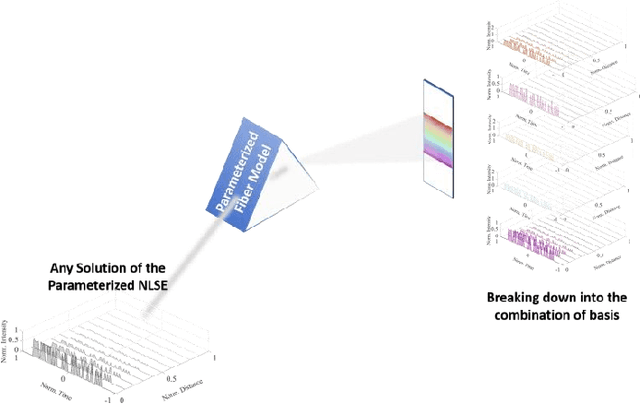
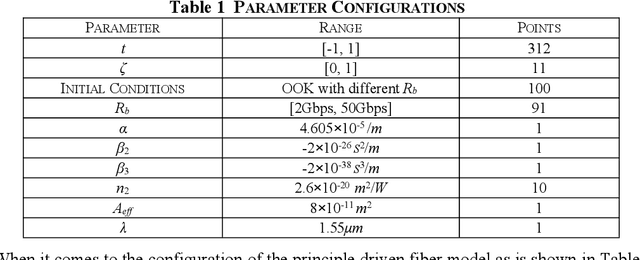

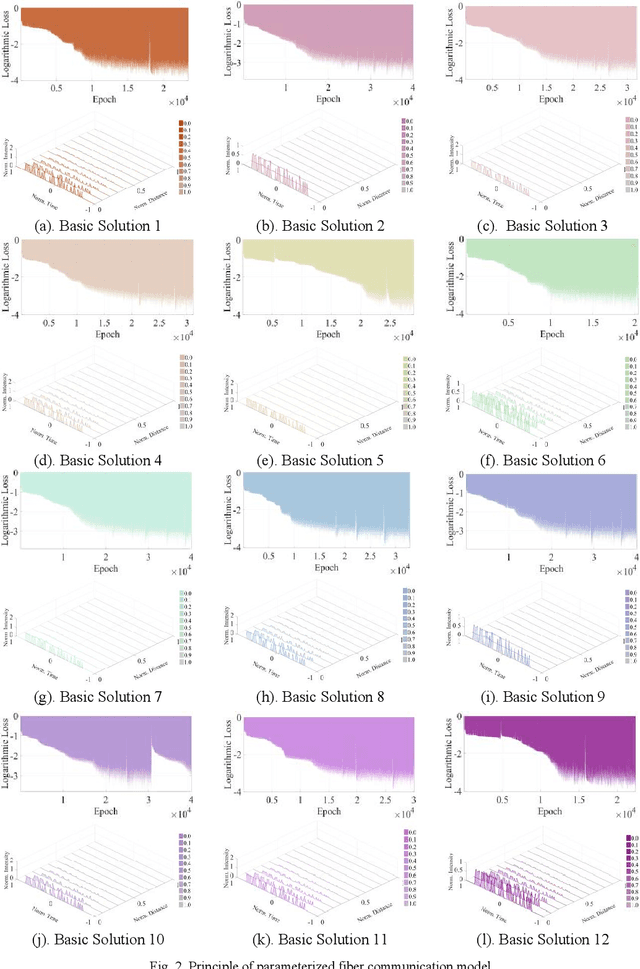
Abstract:In this manuscript, a novelty principle driven fiber transmission model for short-distance transmission with parameterized inputs is put forward. By taking into the account of the previously proposed principle driven fiber model, the reduced basis expansion method and transforming the parameterized inputs into parameterized coefficients of the Nonlinear Schrodinger Equations, universal solutions with respect to inputs corresponding to different bit rates can all be obtained without the need of re-training the whole model. This model, once adopted, can have prominent advantages in both computation efficiency and physical background. Besides, this model can still be effectively trained without the needs of transmitted signals collected in advance. Tasks of on-off keying signals with bit rates ranging from 2Gbps to 50Gbps are adopted to demonstrate the fidelity of the model.
Principle Driven Parameterized Fiber Model based on GPT-PINN Neural Network
Aug 19, 2024Abstract:In cater the need of Beyond 5G communications, large numbers of data driven artificial intelligence based fiber models has been put forward as to utilize artificial intelligence's regression ability to predict pulse evolution in fiber transmission at a much faster speed compared with the traditional split step Fourier method. In order to increase the physical interpretabiliy, principle driven fiber models have been proposed which inserts the Nonlinear Schodinger Equation into their loss functions. However, regardless of either principle driven or data driven models, they need to be re-trained the whole model under different transmission conditions. Unfortunately, this situation can be unavoidable when conducting the fiber communication optimization work. If the scale of different transmission conditions is large, then the whole model needs to be retrained large numbers of time with relatively large scale of parameters which may consume higher time costs. Computing efficiency will be dragged down as well. In order to address this problem, we propose the principle driven parameterized fiber model in this manuscript. This model breaks down the predicted NLSE solution with respect to one set of transmission condition into the linear combination of several eigen solutions which were outputted by each pre-trained principle driven fiber model via the reduced basis method. Therefore, the model can greatly alleviate the heavy burden of re-training since only the linear combination coefficients need to be found when changing the transmission condition. Not only strong physical interpretability can the model posses, but also higher computing efficiency can be obtained. Under the demonstration, the model's computational complexity is 0.0113% of split step Fourier method and 1% of the previously proposed principle driven fiber model.
Principle-driven Fiber Transmission Model based on PINN Neural Network
Aug 24, 2021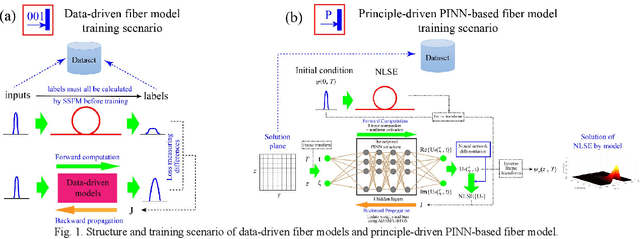
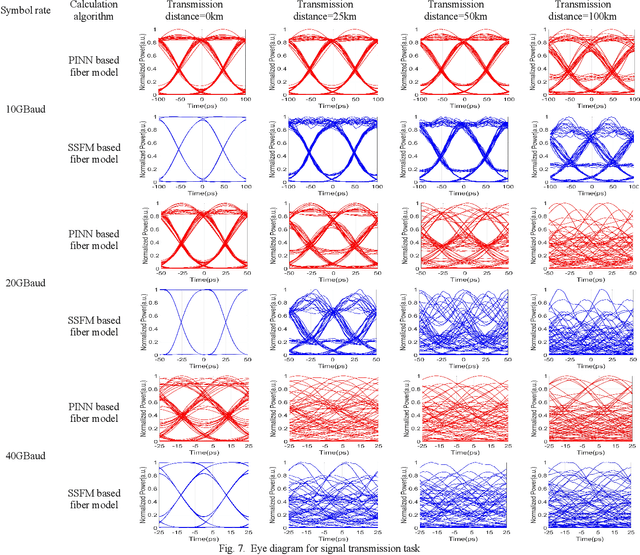
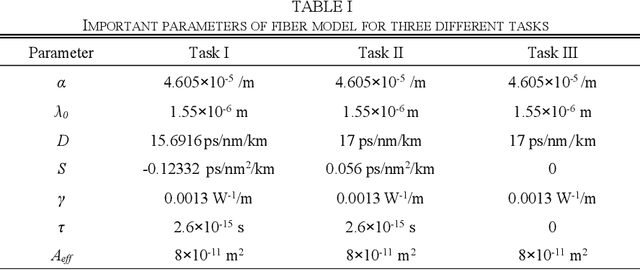
Abstract:In this paper, a novel principle-driven fiber transmission model based on physical induced neural network (PINN) is proposed. Unlike data-driven models which regard fiber transmission problem as data regression tasks, this model views it as an equation solving problem. Instead of adopting input signals and output signals which are calculated by SSFM algorithm in advance before training, this principle-driven PINN based fiber model adopts frames of time and distance as its inputs and the corresponding real and imaginary parts of NLSE solutions as its outputs. By taking into account of pulses and signals before transmission as initial conditions and fiber physical principles as NLSE in the design of loss functions, this model will progressively learn the transmission rules. Therefore, it can be effectively trained without the data labels, referred as the pre-calculated signals after transmission in data-driven models. Due to this advantage, SSFM algorithm is no longer needed before the training of principle-driven fiber model which can save considerable time consumption. Through numerical demonstration, the results show that this principle-driven PINN based fiber model can handle the prediction tasks of pulse evolution, signal transmission and fiber birefringence for different transmission parameters of fiber telecommunications.
Electro-optical Neural Networks based on Time-stretch Method
Sep 13, 2019
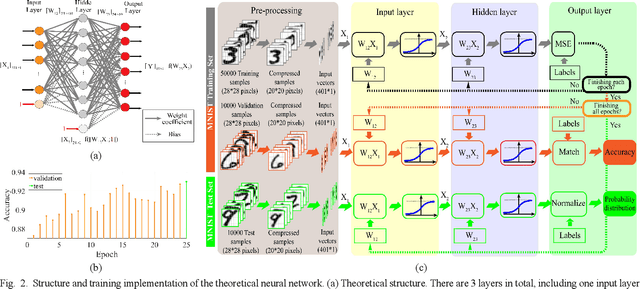
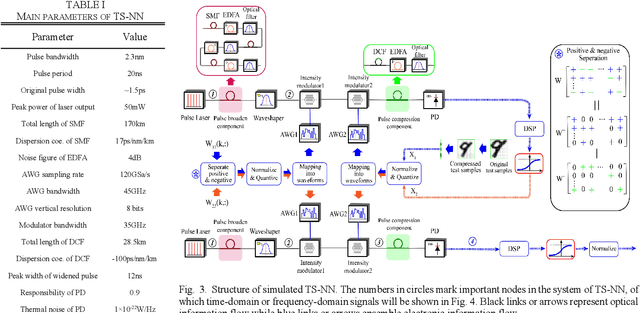

Abstract:In this paper, a novel architecture of electro-optical neural networks based on the time-stretch method is proposed and numerically simulated. By stretching time-domain ultrashort pulses, multiplications of large scale weight matrices and vectors can be implemented on light and multiple-layer of feedforward neural network operations can be easily implemented with fiber loops. Via simulation, the performance of a three-layer electro-optical neural network is tested by the handwriting digit recognition task and the accuracy reaches 88% under considerable noise.
 Add to Chrome
Add to Chrome Add to Firefox
Add to Firefox Add to Edge
Add to Edge